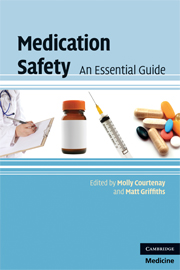Book contents
- Frontmatter
- Contents
- List of contributors
- Preface
- 1 Introduction to medication errors and medication safety
- 2 Safety in prescribing
- 3 Safety in dispensing
- 4 Safety in administering
- 5 Adverse drug reactions and drug interactions
- 6 Interface of care and communication
- 7 Parenteral drug administration
- 8 Calculations
- 9 Controlled drugs and patient safety
- 10 Reporting medication errors and near misses
- 11 Ensuring safety through evidence-based medicine
- Index
- References
5 - Adverse drug reactions and drug interactions
Published online by Cambridge University Press: 22 January 2010
- Frontmatter
- Contents
- List of contributors
- Preface
- 1 Introduction to medication errors and medication safety
- 2 Safety in prescribing
- 3 Safety in dispensing
- 4 Safety in administering
- 5 Adverse drug reactions and drug interactions
- 6 Interface of care and communication
- 7 Parenteral drug administration
- 8 Calculations
- 9 Controlled drugs and patient safety
- 10 Reporting medication errors and near misses
- 11 Ensuring safety through evidence-based medicine
- Index
- References
Summary
This chapter aims to help you consider the problems associated with the prescribing of medicines and their management. You owe it to your patient to ensure that these issues are taken seriously. Failure to manage them can result in patient harm, loss of patient trust in your abilities, and abandonment, by the patient, of worthwhile medication.
Books on adverse drug reactions often include lists of medicines that are associated with different adverse reactions. These lists are difficult to remember and often oversimplify the facts. The first part of this chapter provides a background to adverse drug reactions. The second part looks at drug interactions where the combination of therapies can cause problems. The third part describes some information sources that can be used to manage adverse drug reactions and drug interactions. Overall the aim is to give a general background and explain how to optimize patient care.
Part 1 Adverse drug reactions
Adverse drug reactions (ADRs) are a major drain on NHS resources. In 2002, Bandolier Extra (Wiffen, 2002) stated that 7% of patients admitted to hospital are affected with ADRs. The cost to the NHS in England was estimated to be £380 million per year.
It is often difficult to decide if a patient's symptom is an ADR or a symptom of a new disease. This can lead to patients being exposed to unnecessary investigations and worry while the offending medicine is continued, and the patient continues to be exposed to its adverse effects.
- Type
- Chapter
- Information
- Medication SafetyAn Essential Guide, pp. 63 - 82Publisher: Cambridge University PressPrint publication year: 2009



